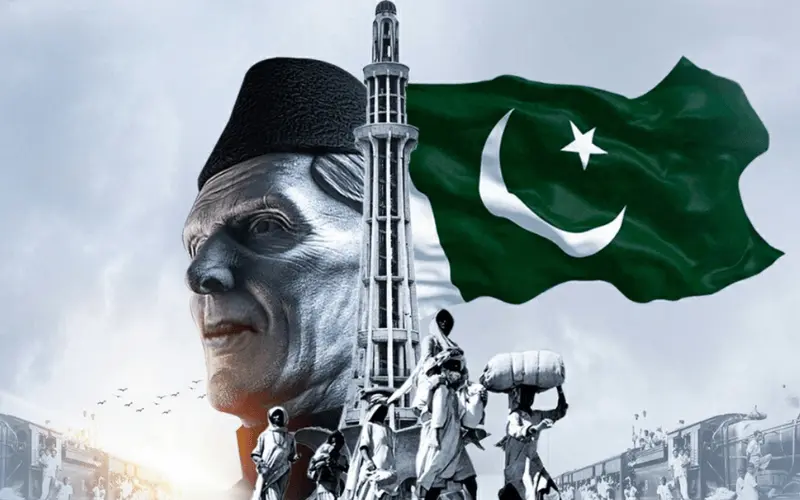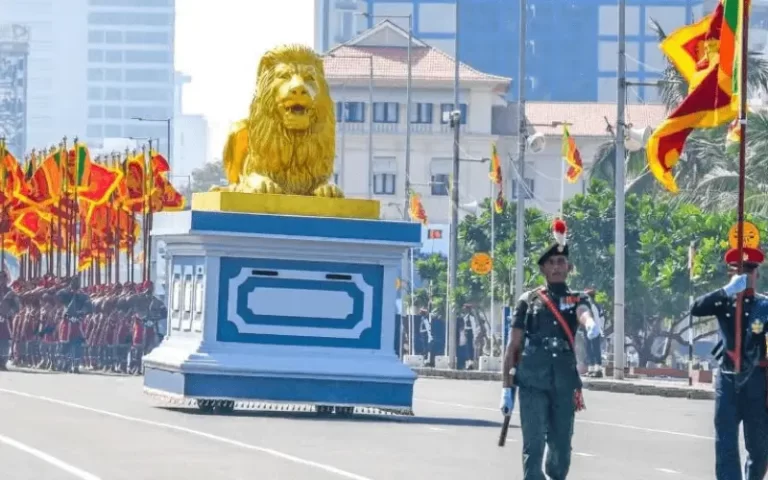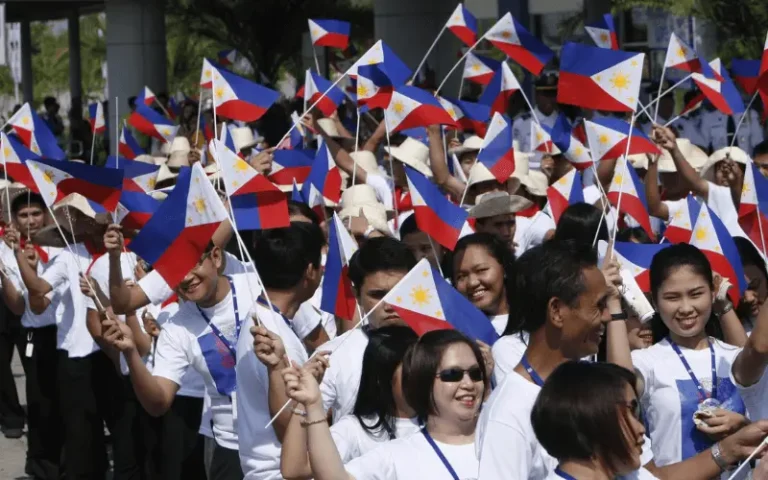Pakistan Independence Day 14 August 1947
Pakistan Independence Day is a special occasion that celebrates the freedom of Pakistan from British rule. It holds great importance as it marks the birth of Pakistan as a separate country for Muslims. This day represents the hard work and dedication of leaders like Muhammad Ali Jinnah, who fought for a united Muslim nation.
Pakistan Independence Day holds great significance in the history and hearts of the Pakistani people. On August 14th of every year, Pakistanis commemorate the day when their nation gained independence from British colonial rule. t serves as a reminder of the struggles, sacrifices, and determination of millions of Muslims who aspired to establish a homeland where they could practice their religion and live per their cultural values, leading to the birth of Pakistan as a sovereign nation.
Stay tuned to know all about Pakistan Independence Day.
History of Pakistan’s Independence?
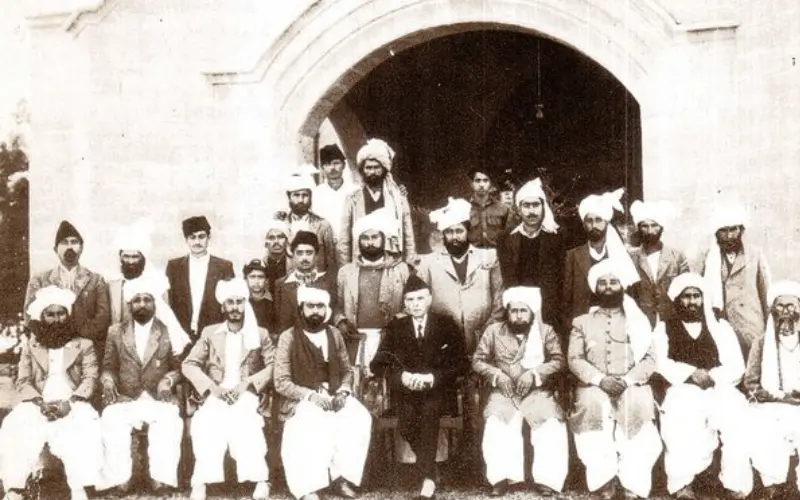
Pakistan Independence Day commemorates the day when Pakistan achieved independence and was declared a sovereign state following the termination of the British Raj in August of 1947.
When is Pakistan Independence Day Celebrated in 2024, 2025, 2026, 2027,2028?
Pakistan Independence Day is celebrated annually on August 14th. The dates and days of Pakistan Independence Day in 2024, 2025, 2026,2027,2028 are mentioned in the following table:
| Year | Pakistan Independence Day Date | Day |
|---|---|---|
| 2024 | 14th August | Wednesday |
| 2025 | 14th August | Thursday |
| 2026 | 14th August | Friday |
| 2027 | 14th August | Saturday |
| 2028 | 14th August | Sunday |
How is Pakistan Independence Day Celebrated?
1. Flag Hoisting and 31-Gun Salute
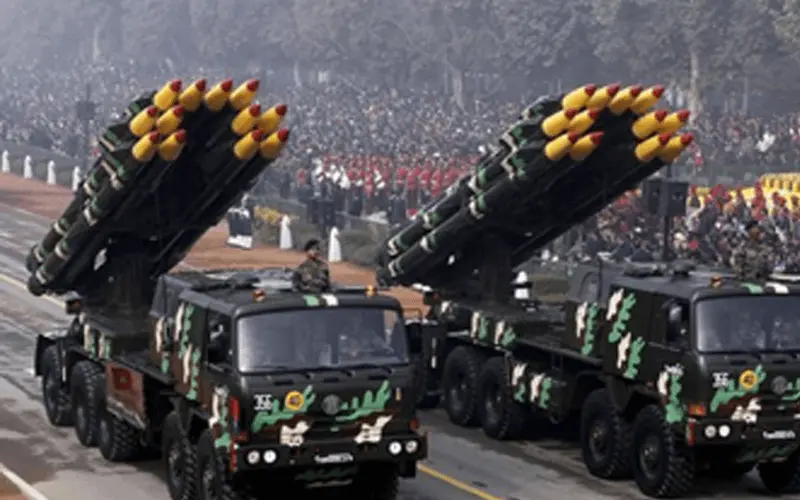
The day kicks off with patriotic fervor as a 31-gun salute echoes in the federal capital, complemented by a 21-gun salute in all four provincial headquarters. Throughout the nation, prayers are offered for Pakistan’s security, progress, development, and the well-being of its people. The iconic green and white of Pakistan’s National Flag adorns both private and public buildings.
2. National Flag Hoisting Ceremony
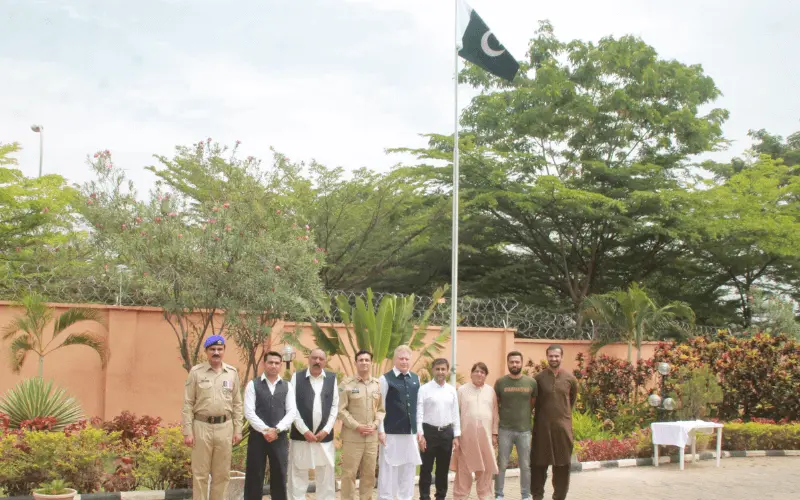
The centerpiece of the celebrations unfolds at the Jinnah Convention Centre in Islamabad. The National Flag hoisting ceremony, graced by the President and Prime Minister, captivates the nation. As the flag unfurls, the crowd joins in unison to sing the national anthem, symbolizing unity and patriotism. Similar ceremonies resonate at provincial, divisional, and district levels.
3. Air Shows and Aerobatic Moves
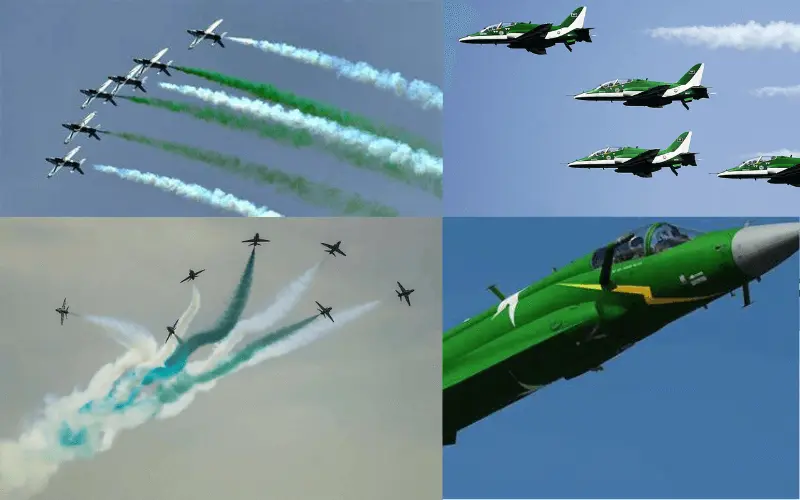
The Pakistan Air Force takes to the skies with a breathtaking air show. Pakistani, Saudi, and Turkish fighter planes grace the skies over Islamabad, executing mesmerizing aerobatic moves. Crowds gather in city parks to witness this spectacular display, marking the nation’s Independence Day with pride.
4. Azadi Parade – A Salute to Sacrifices

The Azadi Parade, a major highlight, pays homage to the sacrifices that led to Pakistan’s creation. Held at the Pakistan Military Academy Kakul, the parade features the Chief of Army Staff and the Prime Minister as chief guests. It symbolizes the commitment of the youth to safeguard their freedom.
5. Karachi’s Grand Celebrations
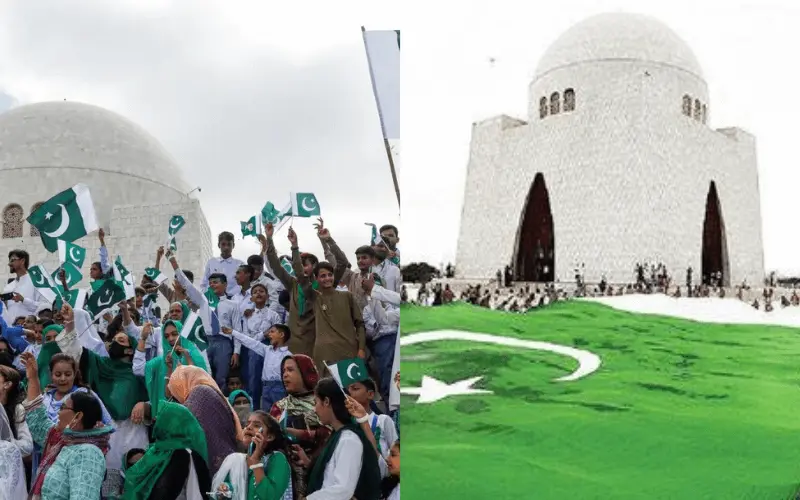
Karachi takes the lead in hosting grand events, with a parade at the mausoleum of Muhammad Ali Jinnah stealing the spotlight. Visitors pay homage to Quaid’s tomb, honoring the founder of the nation. The city pulsates with energy, adorned with green and white lights, flags, and patriotic decorations.
6. Street Celebrations

Throughout Pakistan, the 14th of August is marked by enthusiastic street celebrations. Homes, streets, and towns come alive with the vibrant colors of green and white. Small stalls dot every corner, offering flags, shirts, caps, and wristwatches. Illuminated public and private buildings, along with banners and posters, further amplify the patriotic spirit.
7. Prime Minister’s Inspirational Address

The Prime Minister addresses the nation with an inspiring Pakistan Independence Day speech, paying tribute to the leaders of the Independence Movement and the brave souls who sacrificed for freedom. Emphasizing unity, strength, and hard work, the Prime Minister sets the tone for the collective journey ahead.
8. Diverse Celebrations Across Cities
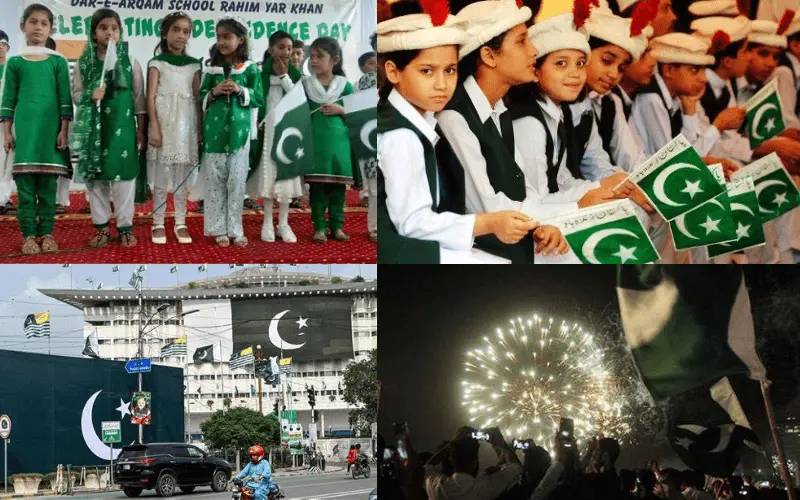
Fireworks, exhibitions, game shows, and face painting add flair to Independence Day celebrations in cities like Karachi, Lahore, Islamabad, and Peshawar. The vibrancy of the celebrations mirrors the unity and pride of the Pakistani people.
9. Citizens’ Zealous Participation
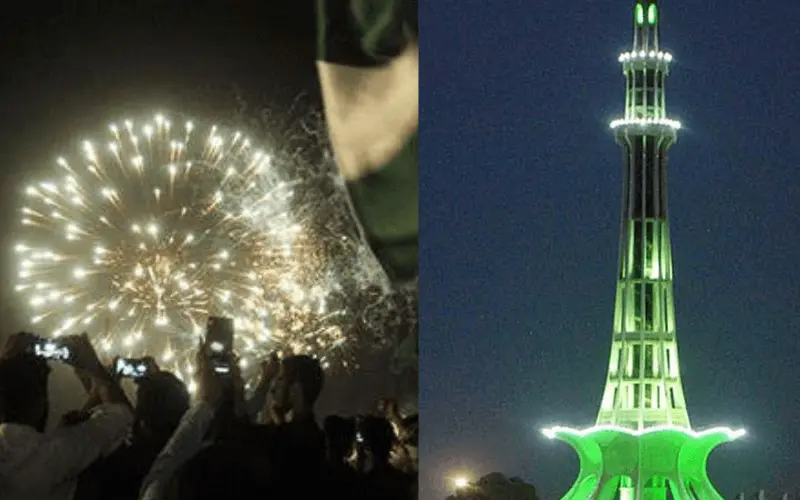
Citizens of Pakistan engage zealously in the celebrations, donning the country’s colors. Flags are prominently displayed, and fireworks light up the skies. Declamation contests, art exhibitions, national song recitals, and sports marathons organized by schools and universities reflect the diversity of the celebrations.
What Pakistan Flag Represent?
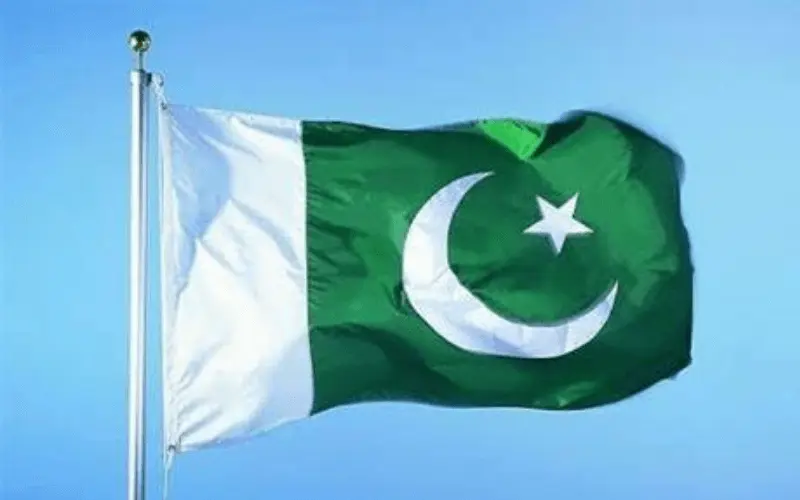
The green part is about Islam, the main religion, showing unity and faith. The white stripe is for the religious minorities, telling us that Pakistan welcomes and respects everyone, no matter their beliefs. Together, these colors show how Pakistan aims for unity among different religions and values harmony among its people.
What Is The National Anthem of Pakistan?
The national anthem of Pakistan is called “Qaumī Tarānah” (The National Anthem). The lyrics were written by Hafeez Jullundhri in 1952, and the music was composed by Ahmed G. Chagla in 1949.
“Qaumī Tarānah” (The National Anthem)
Pāk sarzamīn shād bād
Kishwar-e haseen shād bād
Tū nishān-e azm-e-‘ālīshān
Arz-e Pākistān!
Markaz-e yaqīn shād bād
Pāk sarzamīn kā nizaam
Quwat-e ukhuwat-e ʿawām
Qaum, mulk, saltānāt!
Pāinda tabindah bād!
Shād bād manzile murād
Parčam-e sitārah-o-hilāl
Reḥbar-e taraqqī-o-kamāl!
Tarjumān-e māzī, shān-e hāl
Jān-e istaqbāl!
Saye Khuda-e-Zuljalal
What is the Ideology of Pakistan?
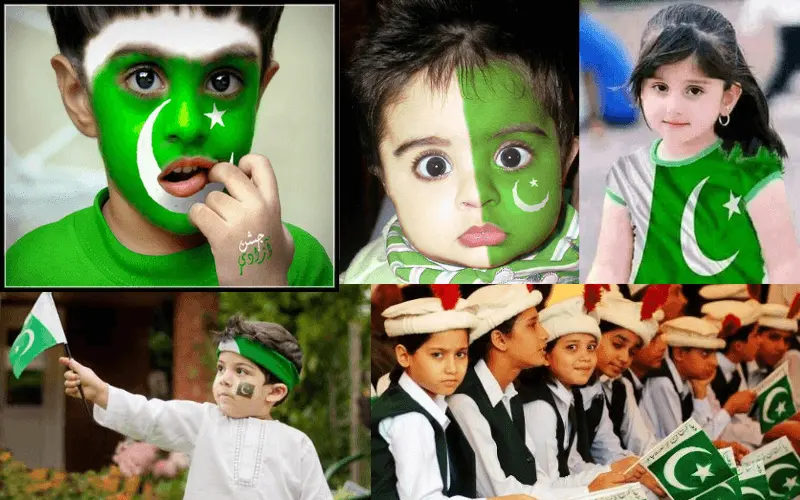
The ideology of Pakistan revolves around the idea of creating a separate homeland for Muslims as a permanent solution to Hindu-Muslim communal tensions in British India. This concept was rooted in the belief that Muslims, as a distinct religious and cultural community, needed a sovereign state where they could exercise their rights and freely practice their faith without facing the challenges posed by a Hindu-majority political structure.
The vision for Pakistan was articulated by leaders like Allama Iqbal and Muhammad Ali Jinnah, who advocated for the establishment of an independent state for Muslims to ensure their political, social, and economic well-being. The partition of British India in 1947 led to the creation of Pakistan as a distinct nation, comprising East Pakistan (present-day Bangladesh) and West Pakistan (present-day Pakistan).
The underlying ideology emphasizes the principles of religious freedom, self-determination, and the creation of a nation where Muslims can shape their destiny according to their cultural, social, and religious values. It reflects a commitment to pluralism, diversity, and the protection of minority rights within the framework of an Islamic state.
What about the defense forces of Pakistan?

Pakistan possesses the world’s sixth-largest army, consisting of about 550,000 active personnel and 500,000 reserves. The defense forces of Pakistan include the Army, Navy, and Air Force, collectively known as the Pakistan Armed Forces.
This professional and volunteer fighting force underscores the country’s commitment to a robust defense. With modern weaponry and skilled personnel, the Pakistani defense forces play a crucial role in ensuring national security and territorial integrity, contributing to regional stability.
Map of Pakistan
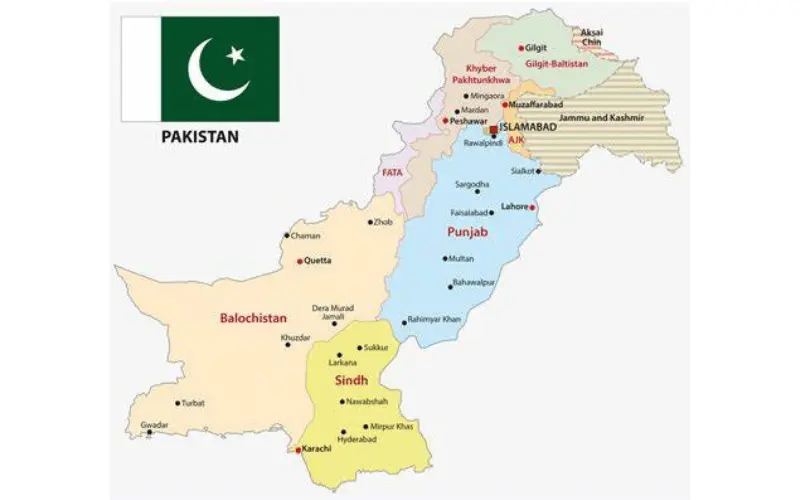
Key Facts About Pakistan
| Key Facts | Information |
|---|---|
| Area of Pakistan | Approximately 796,095 km² |
| Population of Pakistan | Over 241.49 million (latest estimates) |
| National Language of Pakistan | Urdu |
| National Bird of Pakistan | Chukar Partridge |
| National Animal of Pakistan | Markhor (Wild Goat) |
| National Game of Pakistan | Field Hockey |
| National Dress of Pakistan | Shalwar Kameez |
| Pakistan Majority Religion | Islam |
| Capital of Pakistan | Islamabad |
| Founder of Pakistan | Muhammad Ali Jinnah |
| National Poet | Allama Iqbal |
| Currency | Pakistani Rupee (PKR) |
| Main Exports | Textiles, rice, sports goods, among others |
| First Prime Minister | Liaquat Ali Khan |
| First President | Iskander Mirza |
| Major Rivers | Indus, Jhelum, Chenab, and others |
| Forest Coverage | Approximately 4.4% of total land area |
| Years of Independence (2024) | Celebrating the 77th year of Independence |
Pakistan Independence Day Quotes
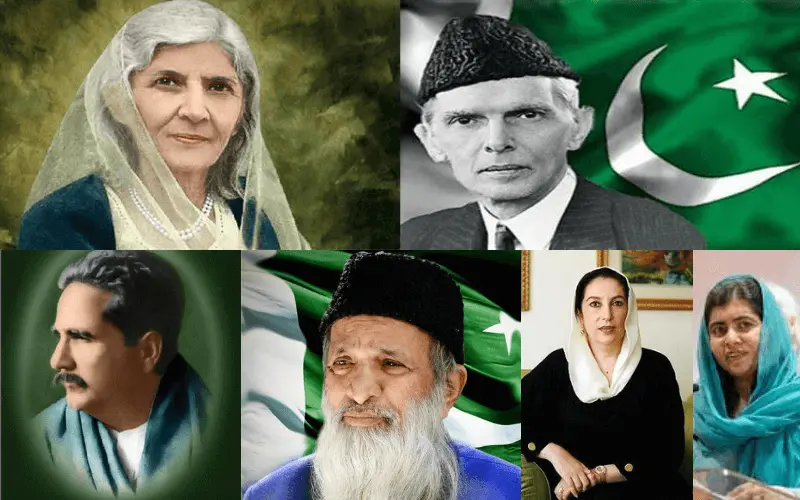
We are going through fire: the sunshine has yet to come. But I do not doubt that with Unity, Faith, and Discipline we will compare with any nation of the world
Muhammad Ali Jinnah
There is no power on earth that can undo Pakistan.
Muhammad Ali Jinnah
Nations are born in the hearts of poets, they prosper and die in the hands of politicians.
Allama Iqbal
Democracy is necessary to peace and to undermining the forces of terrorism.
Benazir Bhutto
I speak not for myself but for those without voice… those who have fought for their rights… their right to live in peace, their right to be treated with dignity, their right to equality of opportunity, their right to be educated.
Malala Yousafzai
No religion is higher than humanity.
Abdul Sattar Edhi
My brother, my companion in arms, and my comrade in the struggle for the emancipation of the Muslims of India.
Fatima Jinnah
Conclusion
Pakistan Independence Day celebrated on August 14th, marks the nation’s freedom from British rule in 1947. Rooted in the vision of leaders like Muhammad Ali Jinnah and Allama Iqbal, the day signifies the creation of a separate homeland for Muslims, emphasizing unity in diversity. The celebrations reflect a commitment to Islamic principles, inclusivity, and progress, making it a day of national pride and reflection on the journey towards independence.
Wishing all Pakistanis a joyous Pakistan Independence Day! May the spirit of freedom and unity continue to thrive in the hearts of the people of Pakistan. Happy Independence Day!
Frequently Asked Questions
What happened on 14 August 1947?
On 14 August 1947, Pakistan achieved independence from British rule. This historic day marked the formal creation of the sovereign state of Pakistan, allowing the people to govern themselves and shape their destiny. Muhammad Ali Jinnah, the founder of Pakistan, played a pivotal role in leading the nation to this momentous occasion, and the day is now celebrated annually as Pakistan Independence Day.
Why do India and Pakistan have different Independence Day?
India and Pakistan have different Independence Days because of Lord Mountbatten’s busy schedule. He was in charge of the transition of power from British rule to independence. To make it easier, they chose different dates for India and Pakistan. India celebrates Independence Day on August 15, and Pakistan celebrates it on August 14. This was done so that the transition could happen quickly and smoothly.
Read other National Independence Day Guides by daysdiscuss
India Republic Day|Celebrating 75 Glorious Years on January 26th
Qatar National Day| December 18| Discover the Essence and Grandeur
Sri Lanka Independence Day 2024 (Discover the Rich History, Celebrations, and Dates)
Australia Day| Everything You Need to Know
Serbia Statehood Day (Everything You Need To Know )

